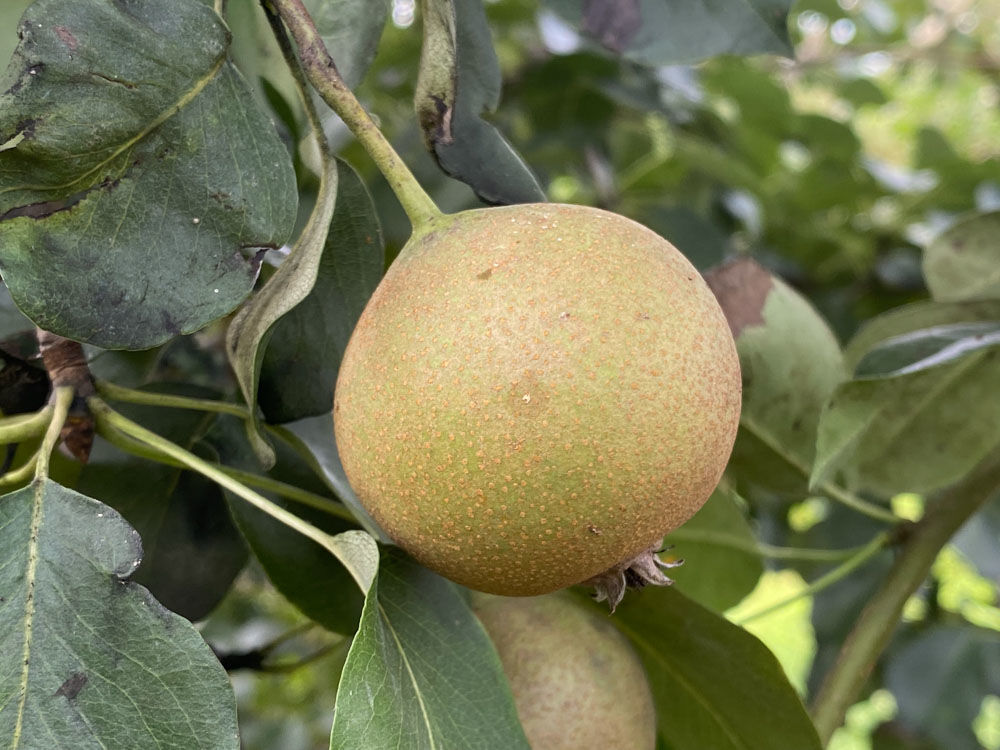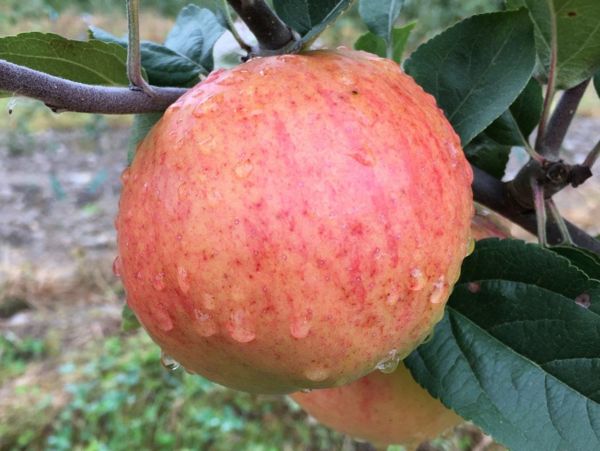An attractive, highly disease-resistant apple, ideal for organic growers.
Barland Pear Scionwood (Spring 2024)
An early to midseason traditional perry pear, high in acids and tannins. Also known as Bareland, Bosbury, Bare Land, Bear Land.
Barland grows on a very large and attractive tree that is famously long-lived. It is scab and mildew susceptible, and a triploid, requiring two diploid pollenizers for full fertility. The fruit is small, dull green or yellow with a grey russet; It is high in acids and tannins. This pear is used exclusively for cider and it is not suitable for fresh eating. The fruit should be milled within three days after harvest.
The ultimate origin of Barland is not known and DNA analysis has proved inconclusive. We do, however, have evidence of its cultivation from 1656, when Rev. John Beale described a famous Bosbury pear as so hard and coarse that pigs would not eat it. This was, apparently, the pear grown at Barelands Farm, which was famous for its peare cider. Furthermore, by the time John Evelyn published his work Pomona (1664), the Barland pear seems to have been extensively cultivated for cider production. According to George and John Lindley (1831), the original tree grew in a field called Bare Lands, in the parish of Bosbury in Herefordshire, but it was blown down a few years before 1811.
The cider produced by Barland is described by Richard Bradleey (1731): "the Neighbourhood of Bosbury is famous for a peculiar Perry, which hath many of the masculine Qualities of Cyder. It is quick, strong and heady, high-coloured, and retaineth a good Vigour two or three Summers; yea, in great Vesssels and good cellars many Years, before it declineth. ... This Bosbury Pear is there called the Bareland Pear; and as the Liquor approacheth to Apple-Cyder in Colour, Strength, and excelleth in Durance; so the Bloom cometh forth of a damask Rose Colour, like Apples, not like other Pears." (From Brooks and Olmo: juice acidity 0.92, tannins 0.26, specific gravity 1.058.)
Volume Pricing
| Quantity | Barland Pear Scion |
|---|---|
| 1 | $12.00 |
| 2-5 | $7.00 |
| 6-10 | $6.00 |
| 11-99 | $5.00 |
| 100+ | $4.00 |
The Fruit
Fruit Type
Category: Pear
Subcategory:
Perry
Fruit Uses & Storage
Uses: cider
Cider classification: bittersharp
Storage duration: (approximate, depending on storage conditions)
Fruit Appearance
Skin color: green
Flesh color: off-white
Fruit Origins
Parentage: unknown
Origin: Herefordshire, England
Introduced in: 1600s
Introduced by:
The Environment
Calendar & Geography
USDA zones: 5 - 7
Chill hours: Not yet determined
Ripening date: Aug 13 (approximate, in New York State) 7 days before Bartlett
Diseases & Pests
glossary
Pear Scab: Susceptible
Powdery Mildew: Susceptible
Pollination
Pollination Factors
glossary
Bloom group: 3
Is it self-fertile? N
Is it fertile? N
Ploidy: Triploid
Pollination Partners
This table shows the first few results from a full search for pollenizers of Barland Pear. Please see our Pollenizer Search to run other queries and read how the application uses various factors. Also read more about fruit tree pollination.
| Tree | Currently in Stock |
|---|---|
| Winnal's Longdon Pear | 0 |
| Brandy Pear | 0 |
| Yellow Huffcap Pear | 0 |
| Gin Pear | 0 |
| Butt Pear | 0 |
| Hendre Huffcap Pear | 0 |
See all pollination matches for Barland Pear
Featured Products
A few things we're loving right now...
A full-flavored, freestone white peach.
A traditional semisharp cider apple from Spain.
A widely-grown, large, yellow-fleshed nectarine.


















